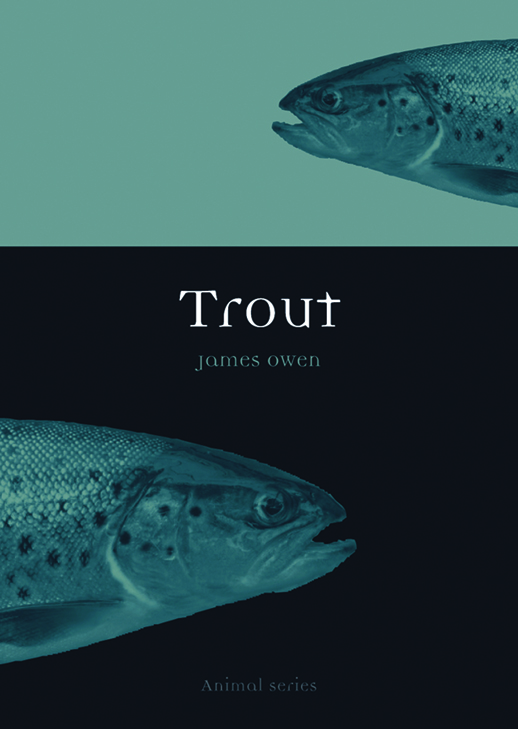
Trout by James Owen
Published by Reaktion Press. Paperback, 190 pages, 97 illustrations
A review by Theo Pike
Why do we need another book about trout?
For those of us whose bookshelves may already be groaning under the weight of Schwiebert’s, Watson’s, and Frost and Brown’s volumes of the same name (not to mention Everard’s Dace, Roach and Little Book of Little Fishes, as well as Giles’ Nature of Barbel and, yes, Trout), this is probably quite a relevant question.
Speaking personally, however, I think it’s one that this younger pretender answers in some style. For one thing, James Owen’s Trout brings the story right up to date. Even Giles’ influential study is already 7 years old, and things have been moving fast in recent trouty history (to put this in perspective, in 2005 Youtube was launched, Dubya signed up for his second term, and we’d just listened to James Blunt’s You’re Beautiful for the very first time).
But we’ll go back to the future in just a minute, because Owen is really rather good on the past. As a regular columnist for Trout & Salmon and National Geographic, his tone of voice is practised, crisp and slightly wry, and he fillets out a fascinating smorgasbord of facts, figures, intriguing images and telling cultural details that show just how thoroughly Salmo Trutta has become part of our global heritage and consciousness.
Naturally, as Owen explains, this deep cultural link far pre-dates the well-intentioned diasporae of brown and rainbow trout, inheritors of Victorian values of Acclimatization and techniques of piscifactoire that seem to have been independently developed at least three times – last and most effectively at Huningue in Alsace, which France lost in the Franco-Prussian War, arming the new German Empire with the perfect ammo for trout-centric imperialism.
Long before American anglers started grumbling about “dirty German trout” which didn’t just displace their native brookies but also proved wilier and harder to catch, Ainu culture regarded a giant trout as the foundation of the world, responsible for everything from tides to earthquakes. Other religions followed suit: you can still visit sacred wells on the Celtic Fringe where trout were credited with atavistic powers of healing, fortune-telling and shape-shifting, which WB Yeats distilled and immortalised in his Song of Wandering Aengus. And maybe most intriguingly, it seems to have been Viktor Schauberger’s semi-spiritual response to the way of a trout with a current of cold water that inspired the legendary Nazi flying saucer programme, complete with blueprints and prototypes that were mysteriously destroyed in the wreckage of 1945… or were they?
In short, this is a brilliant little miscellany of trouty facts, fictions and stuff we should all know. And, as promised, it brings the story right up to date, complete with well-footnoted discussion of the latest thinking on trout conservation and genetics, from Norway’s forests to Albania’s Lake Ohrid, and the globe-spanning efforts of WFF, Trout Unlimited and its British equivalent, the Wild Trout Trust. And so we come home to my own local water: South London’s River Wandle, where a “riverine Lazarus act” and the miraculous discovery of a single tiny wild trout fry provide the context for Owen’s concluding message of hope for the curious contract between man and salmonid:
“Let us hope it marks a bright new chapter for the London trout, and in our evolving relationship with this wonderful creature. We have seen the trout revered, lauded, propagated, exported, scientifically altered, devoured, trashed and, finally, revived. Our intertwined histories have made the fish a totem of our Jekyll-and-Hyde response to nature. We celebrate the trout for its vitality and wildness, yet domicile it and mass-produce it in concrete tanks; we have gone to amazing lengths to establish the fish in the farthest reaches of the world, yet pollute and degrade the waters at our own back doors…
“People once sought audiences with sacred trout to know their futures. Perhaps we seek the fish for the same reason today. We who glance over the parapet of our hurly-burly existence look into the shadowy water for reassurance. For the reassurance of this wild, beautiful presence. For the possibility of such a glorious thing as trout.”
It’s undeniable: trout are indeed “an ancient fascination”. And that’s why it turns out we really do need this book.
Trout, is now on sale from the Caught by the River shop, priced £8.00
Theo Pike’s Trout in Dirty Places: 50 rivers to fly-fish for trout and grayling in the UK’s town and city centres will be published by Merlin Unwin Books on 3 April 2012.